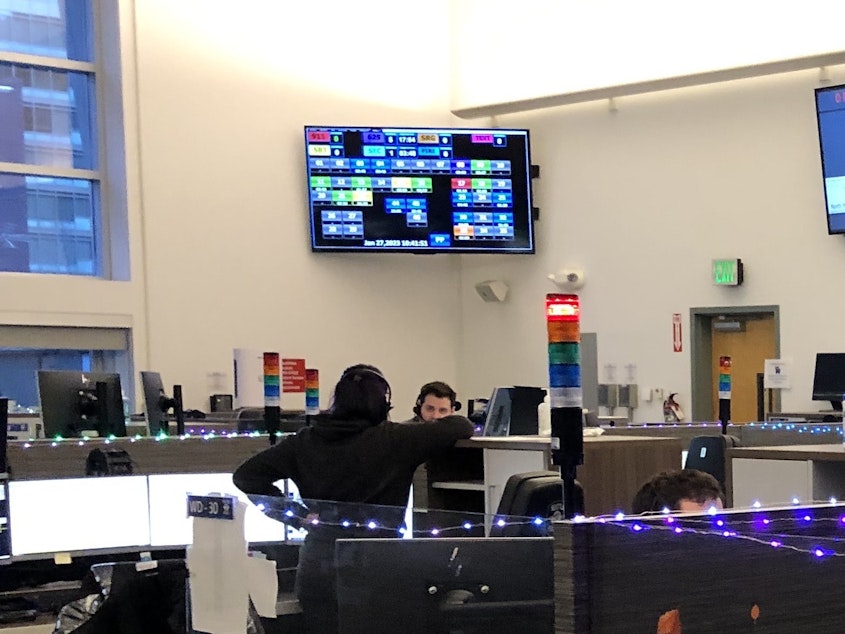Should downtown Seattle go from office space to living space?: Today So Far

- Why not turn empty office space into needed housing space?
- Seattle's cost-of-living woes have expanded beyond Western Washington. Eastern Washington communities are now seeing rising rents and other costs.
- Washington is among a handful of states taking aim at foreign entities that want to buy U.S. farmland.
This post originally appeared in KUOW's Today So Far newsletter for February 16, 2023.
Here's the situation: Downtown Seattle has a lot of empty office space, and it doesn't look like it will fill back up soon; at the same time, the city severely needs more housing.
Why not turn that office space into living space? That's an idea that has imaginations lighting up around Seattle.
As KUOW's Joshua McNichols puts it, downtown Seattle has financially been supported by three core groups: office workers, tourists, and residents. Office workers have been disappearing, and tourism slumped over the past few pandemic years. In turn, downtown has taken a few hits. That has folks thinking about ways to revitalize the area, included in that thought is the potential of converting office space to living space, and perhaps more.
"We could adapt oversized retail spaces, too, build some interior walls, or take some out, carve those spaces up into new kinds of spaces that allow new uses that we haven't thought of before," Joshua says in his recent story covering this issue. "Could underused offices also become day cares, schools, or performance spaces?"
Joshua's story reminded me of a visit to see my brother in Kansas City, years ago. He had found an apartment in a corner of the city that was previously more industrial. The building was not initially intended to be a residential space, but times changed. It was converted, and the resulting apartments were impressive. I would have rather lived there than in most buildings built for apartments. Similar moves have been made in Portland, Ore., around its Pearl District, though admittedly, residents there are clearly in a higher tax bracket.
Sponsored
The result of such moves made my brother's corner of Kansas City more active and productive. The farmers' market was up and running during the day, diners, pubs, barbers, and more operated into the night. In other words, the neighborhood was alive, instead of brief daytime activity before going dead after 5 p.m. (sound familiar?).
Tacoma has experimented with this idea too, and has already been converting office spaces into residential spaces for a while now. Seattle could benefit from that experience. But that doesn't mean there aren't challenges around such office-to-housing conversions. It also raises an important question: Who is downtown Seattle for? Check out Joshua's full story on this issue here.
Seattle's cost-of-living woes have expanded beyond Western Washington. Eastern Washington communities are now seeing rising rents and other costs.
"Living in Yakima, I have seen housing costs increase both to buy homes as well as rent," Crosscut reporter Mai Hoang told Soundside. "What surprised me when I actually looked at the data was how severe the increases were, and how severe it was in certain places."
Hoang recently reported on the rising costs of living on the east side of Washington state for Crosscut. It's not just Yakima. Other communities like Walla Walla and Spokane are experiencing rising costs of living, to a level that is pushing out many established community members. Part of the issue, according to Hoang's reporting, is that a shift to remote work during the pandemic gave people an option to live in areas they are more attracted to — smaller towns and cities, and areas closer to outdoor recreation, etc. Just as Seattle has seen after waves of higher and higher paychecks flooding into the city, other communities have now observed rents rising.
Sponsored
"The main thing that stood out for me was, when you have residents that can't afford to live in a community, the community changes from the diverse community with people across different social economic backgrounds, and different diversity to this playground for the rich," Hoang said. "Because those are the only people that can afford to live in that community."
Check out Soundside's story here.
Washington is among a handful of states taking aim at foreign entities that want to buy U.S. farmland. A bill is working its way through the Capitol in Olympia that would place restrictions on foreign buyers of local farmland. The proposal has drawn criticism, primarily from lobbyists for industries like timber and food processing.
"I know that a lot of people are concerned about China owning ag lands in the United States," said Tom Davis of the Washington Forest Protection Association at a recent committee hearing for the bill. Davis added that Canadians are the most common foreign investors in rural U.S. counties, followed by Europeans.
"I ask that you look at this more carefully," Davis said. "The bottom line, shouldn't the consideration of limitations on land ownership be directed at those foreign countries that we believe to be hostile to the U.S., and not to the Netherlands, to the UK and Germany?"
Sponsored
On the other side of this issue are the bill's supporters, like Rep. Clyde Shavers (D-Oak Harbor), who represents part of the Skagit Valley. He argues that, "Buying and investing in water rights leaves a pathway for foreign entities to gradually deplete local water supplies from our local farmers."
Northwest News Network's Tom Banse has the full story here.
AS SEEN ON KUOW

A red light atop a cubicle in Seattle's 911 call center alerts colleagues not to interrupt dispatchers while they're using the police radio. Seattle is testing a big change in its 911 response. The city plans to add a team of civilian mental health professionals to its 911 center later this year. It’s a small pilot project that's part of a move away from traditional police responses for certain emergencies. (Amy Radil / KUOW)
Sponsored
DID YOU KNOW?
The very first 911 call was made 55 years ago on Feb. 6, 1968. It came about a year after Congress approved the idea of a single number used to report emergencies (the UK had been using 999 for the same purpose since the 1930s). While the government though it was a good idea, the number itself, "911," was chosen by AT&T, which was the dominant phone company in the USA at the time. The effort to create the emergency system began in the 1950s at the request of the National Association of Fire Chiefs, which felt a simple, single phone number was needed across the country to report emergencies.
Alabama Rep. Rankin Fite (speaker of Alabama's House of Representatives) made that first 911 call in 1968. The call was likely just for show — U.S. Rep. Tom Bevill picked up the 911 call at the other end of the line.
Still, at this time, the emergency number was not widely used across the United States. In 1973, the White House issued a statement encouraging the widespread adoption of 911. Even then, it took a while for locals to catch on. By 1987, 50% of the United States had set up 911 systems.
Call centers have become more advanced since then. Seattle is currently running a pilot program at its 911 call center that incorporates a team of civilian mental health professionals into the system.
Sponsored
ALSO ON OUR MINDS

Ukraine says it shot down 6 Russian balloons that appeared over Kyiv
The Kyiv Military Administration says it shot down six Russian balloons that appeared over the Ukrainian capital during an air raid warning on Wednesday. Similar balloons had appeared in other parts of Ukraine on Sunday.

